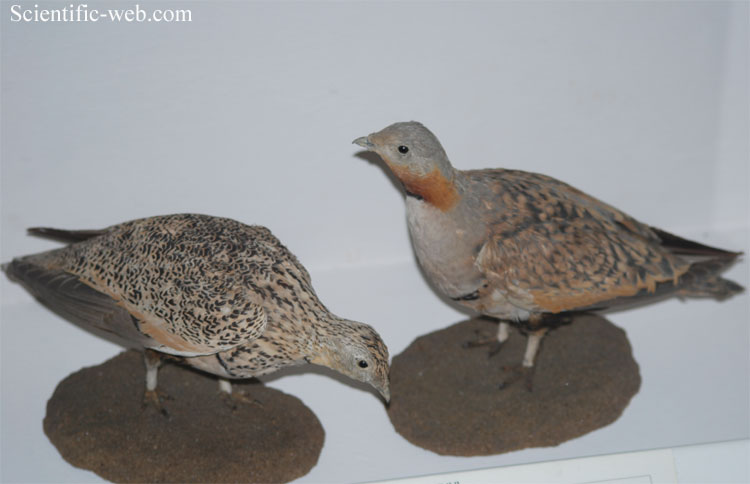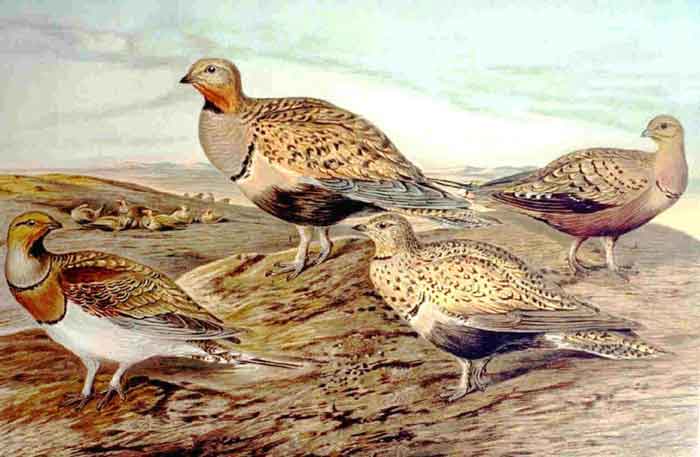
Pterocles orientalis, Photo: Michael Lahanas
Superregnum: Eukaryota
Cladus: Unikonta
Cladus: Opisthokonta
Cladus: Holozoa
Regnum: Animalia
Subregnum: Eumetazoa
Cladus: Bilateria
Cladus: Nephrozoa
Superphylum: Deuterostomia
Phylum: Chordata
Subphylum: Vertebrata
Infraphylum: Gnathostomata
Megaclassis: Osteichthyes
Cladus: Sarcopterygii
Cladus: Rhipidistia
Cladus: Tetrapodomorpha
Cladus: Eotetrapodiformes
Cladus: Elpistostegalia
Superclassis: Tetrapoda
Cladus: Reptiliomorpha
Cladus: Amniota
Classis: Reptilia
Cladus: Eureptilia
Cladus: Romeriida
Subclassis: Diapsida
Cladus: Sauria
Infraclassis: Archosauromorpha
Cladus: Crurotarsi
Divisio: Archosauria
Cladus: Avemetatarsalia
Cladus: Ornithodira
Subtaxon: Dinosauromorpha
Cladus: Dinosauriformes
Cladus: Dracohors
Cladus: Dinosauria
Ordo: Saurischia
Cladus: Eusaurischia
Subordo: Theropoda
Cladus: Neotheropoda
Cladus: Averostra
Cladus: Tetanurae
Cladus: Avetheropoda
Cladus: Coelurosauria
Cladus: Tyrannoraptora
Cladus: Maniraptoromorpha
Cladus: Maniraptoriformes
Cladus: Maniraptora
Cladus: Pennaraptora
Cladus: Paraves
Cladus: Eumaniraptora
Cladus: Avialae
Infraclassis: Aves
Cladus: Euavialae
Cladus: Avebrevicauda
Cladus: Pygostylia
Cladus: Ornithothoraces
Cladus: Ornithuromorpha
Cladus: Carinatae
Parvclassis: Neornithes
Cohors: Neognathae
Cladus: Neoaves
Cladus: Columbimorphae
Ordo: Pterocliformes
Familia: Pteroclidae
Genus: Pterocles
Species: Pterocles orientalis
Subspecies: P. o. aragonica – P. o. arenarius – P. o. bangsi – P. o. orientalis
Name
Pterocles orientalis (Linnaeus, 1758)
Synonyms
Tetrao orientalis (protonym)
References
Linnaeus, C. 1758. Systema Naturae per regna tria naturae, secundum classes, ordines, genera, species, cum characteribus, differentiis, synonymis, locis. Editio Decima, Reformata. Tomus I. Holmiæ (Stockholm): impensis direct. Laurentii Salvii. 824 pp. DOI: 10.5962/bhl.title.542 BHL p. 161 BHL Reference page.
Vernacular names
العربية: قطا أسود البطن
azərbaycanca: Qaraqarın bağrıqara
brezhoneg: Ganga kof du
català: Xurra
کوردی: کوڕکوڕە
Deutsch: Sandflughuhn
Ελληνικά: Μαυροπεριστερόκοτα
English: Black-bellied Sandgrouse
Esperanto: Nigraventra stepkoko
español: Ganga ortega, ortega
euskara: Ganga azpibeltz
فارسی: باقرقره
suomi: Hietakyyhky
français: Ganga unibande
magyar: Feketehasú pusztaityúk
հայերեն: Դռլոն սևափոր
日本語: クロハラサケイ
қазақша: Қарабауыр бұлдырық
kurdî: Qitik
Nederlands: Zwartbuikzandhoen
polski: Stepówka czarnobrzucha
پنجابی: کالے ٹڈ آلا ریتگراوز
português: Cortiçol-de-barriga-preta
русский: Чернобрюхий рябок
svenska: Svartbukad flyghöna
Türkmençe: Bagyrtlak
Türkçe: Bayağı bağırtlak
中文: 黑腹沙鸡

Pterocles orientalis (*)
The black-bellied sandgrouse (Pterocles orientalis) is a medium large bird in the sandgrouse family.
The nominate race breeds in Iberia, northwest Africa, the Canary Islands, Turkey, Iran, Cyprus and Israel. The eastern form P. o. arenarius (Pallas, 1775) is found in Kazakhstan, western China and northern Pakistan. It is a partial migrant, with central Asian birds moving to the Pakistan and northern India in winter.
Taxonomy
The black-bellied sandgrouse was formally described by the Swedish naturalist Carl Linnaeus in 1758 in the tenth edition of his Systema Naturae. He placed it with all the other grouse-like birds in the genus Tetra and coined the binomial name Tetra orientalis.[2] The black-bellied sandgrouse is now placed with 13 other species in the genus Pterocles that was introduced in 1815 by the Dutch zoologist Coenraad Jacob Temminck.[3][4] The genus name combines the Ancient Greek pteron meaning "wing" with -klēs meaning "notable" or "splendid".[5]
Two subspecies are recognised:[4]
P. o. orientalis (Linnaeus, 1758) – Canary Islands, Iberian Peninsula, Morocco to west Iran
P. o. arenarius (Pallas, 1775) – Kazakhstan to south Iran and Afghanistan, east to northwest China
Description
The black-bellied sandgrouse is 33–39 cm (13–15 in) long and weighs 300–615 g (10.6–21.7 oz), it is likely the largest species in the sandgrouse family.[6] The male has a grey head, neck, and breast. The underparts are black and the upperparts are golden-brown with darker markings. There is a thin black border around the lower breast, and a chestnut throat patch. This sandgrouse has a small, pigeon like head and neck, but a stocky compact body. It has long pointed wings and a fast direct flight. The white underwings and black belly make this species easy to identify while in flight. Flocks fly to watering holes at dawn.
The female has browner, more finely marked upperparts, including the head and the breast. The underparts and breast band are identical to the male. The eastern race is paler and heavier than orientalis. Males have yellower upperparts and greyer underparts than the western form. Females are whiter below, but often inseparable. The call is a soft chowrrr rrrr-rrrr.
Distribution and habitat
This gregarious species breeds on dry open plains and similar habitats, but unlike the pin-tailed sandgrouse, it avoids areas completely lacking in vegetation. Its nest is a ground scrape into which three greenish eggs with cryptic markings are laid. Both sexes incubate, but only the male brings water.
References
BirdLife International (2018). "Pterocles orientalis". IUCN Red List of Threatened Species. 2018: e.T22693002A131876252. doi:10.2305/IUCN.UK.2018-2.RLTS.T22693002A131876252.en. Retrieved 12 November 2021.
Linnaeus, Carl (1758). Systema Naturae per regna tria naturae, secundum classes, ordines, genera, species, cum characteribus, differentiis, synonymis, locis (in Latin). Vol. 1 (10th ed.). Holmiae (Stockholm): Laurentii Salvii. p. 161.
Temminck, Coenraad Jacob (1815). Histoire Naturelle Générale des Pigeons et des Gallinacés (in French). Vol. 3. Amsterdam: J. C. Sepp et fils. pp. 238, 712.
Gill, Frank; Donsker, David; Rasmussen, Pamela, eds. (January 2022). "Turacos, bustards, cuckoos, mesites, sandgrouse". IOC World Bird List Version 12.1. International Ornithologists' Union. Retrieved 13 August 2022.
Jobling, James A. (2010). The Helm Dictionary of Scientific Bird Names. London: Christopher Helm. p. 322. ISBN 978-1-4081-2501-4.
CRC Handbook of Avian Body Masses by John B. Dunning Jr. (Editor). CRC Press (1992), ISBN 978-0-8493-4258-5.
Pheasants, Partridges and Grouse by Madge and McGowan, ISBN 0-7136-3966-0
Retrieved from "http://en.wikipedia.org/"
All text is available under the terms of the GNU Free Documentation License

